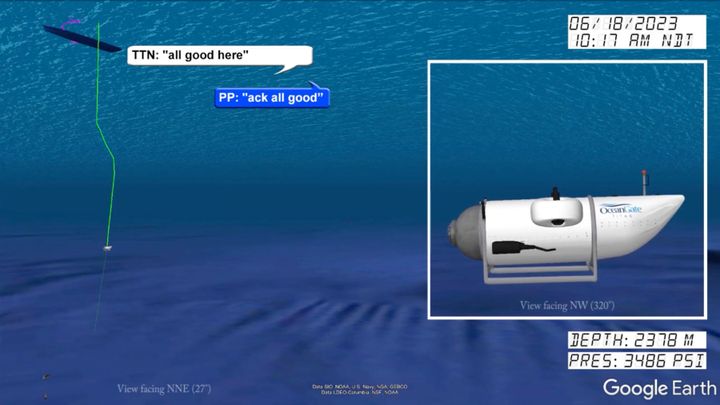The Biggest Revelations From The Titan Submersible Hearing So Far
The ill-fated Titan submersible is back in the spotlight this week as the U.S. Coast Guard holds an investigatory hearing into the circumstances surrounding the implosion of OceanGate’s deep-sea vessel last year, a tragedy that killed all five people on board.
The first two days of testimony have painted an alarming picture of the way OceanGate founder Stockton Rush, who died while piloting the vessel, allegedly ran his company, handled safety concerns from his employees, kept outsiders away from the project, and rushed to bring his submersible to the Titanic wreckage.
Advertisement
Here are the biggest new pieces of information that have been revealed at the hearing thus far, including new images of the vessel’s wreckage and details about the crew’s last communications.
Crew’s Eerie Final Messages Were Revealed
One of the last messages the crew sent to its support, Polar Prince, was “all good here,” according to a visual re-creation the Coast Guard showed on the first day of the hearing.

via Associated Press
The actual final message the crew sent was “dropped two wts,” a reference to the vessel weights used for ascending and descending, investigators revealed. Contact was lost six seconds later.
Advertisement
Rob McCallum, a former advisor to OceanGate, spoke about that message last summer shortly after the implosion, saying it indicated something had gone wrong and the submersible was trying to return to the surface.
First Image Of The Titan’s Wreckage Released
The Coast Guard shared the first image of the Titan’s debris on the ocean floor, showing its tail cone submerged in the sand and surrounded by other fragments from the submersible. It was taken by a remotely operated vehicle, or ROV.
That detached tail cone, which is not part of the crew’s hull, was the “conclusive evidence” the Coast Guard needed to know the Titan had suffered a catastrophic implosion due to water pressure.

U.S. Coast Guard
Titan Was Damaged Years Ago, Called ‘Unsafe’
Tony Nissen, whom OceanGate hired in 2016 as its engineering director, delivered some of the most alarming testimony Monday.
Advertisement
The Titan’s original hull was struck by lightning during a 2018 test mission, doing serious damage to its experimental carbon fiber hull, Nissen testified. He later found a crack in the hull he didn’t think could be repaired, so he refused to approve a planned 2019 mission to the Titanic wreckage. A new hull was eventually put on the submersible that imploded last year.
Coast Guard investigators also said that while in storage, the Titan was left exposed to the elements for about seven months in 2022 and 2023.
Bonnie Carl, OceanGate’s former finance and human resources director, testified Monday that operations director David Lochridge described the Titan as “unsafe.” Lochridge testified Tuesday that he had “no confidence whatsoever” in the submersible’s design.
“I knew that hull would fail,” he said. “It’s an absolute mess.”

U.S. Coast Guard
Head Engineer Refused To Get In The Submersible
Nissen said he had so little faith in OceanGate’s leaders that he refused when Rush asked him to pilot Titan’s missions to the Titanic wreckage.
Advertisement
“I told him, ‘I’m not getting in it,’” Nissen testified, saying he didn’t trust the operations crew or Rush, as well as that there was no designated safety officer at OceanGate.
Nissen added that he sparred with Rush over language disclosing the Titan’s “experimental” design, saying he “made him” include that word in the waivers passengers needed to sign before going on a mission. Carbon fiber is typically used in aerospace design, but it’s an unusual material to deploy in deep-sea exploration. Marine experts and former OceanGate employees all warned against its use years before the fatal implosion.
OceanGate Forced Out Employees Who Raised Concerns
Nissen and Lochridge both testified they lost their jobs after sparring with Rush about the safety of OceanGate’s designs.
“I wouldn’t sign off on it,” Nissen said of a planned voyage in 2019. “So I got terminated.”
Lochridge said he was fired in 2018 after pushing back against Rush’s decisions.
“I didn’t want to lose my job,” Lochridge said. “I wanted to go to Titanic. It was on my bucket list. I wanted to dive this, but dive it safely.”

JASON REDMOND via Getty Images
Advertisement
Both men described Rush as volatile, impatient and pushy. Lochridge said he liked “to do things on the cheap” and was driven by a “desire to get to the Titanic as quickly as we could to start making profit.” Nissen said he often fought with Rush behind the scenes and that “most people would eventually just back down to Stockton. It was almost death by a thousand cuts.”
The Titan’s Hull Was Never Reviewed By Third Parties
Even with its experimental design, the Titan never underwent the standard safety review by a third party, Coast Guard investigators said Monday.
Reports last summer revealed that the Marine Technology Society, an organization comprising ocean engineers and policymakers, expressed concerns about that lack of a safety check. The Associated Press also reported at the time that in a 2019 company blog post, OceanGate criticized the third-party certification process as time-consuming and innovation-limiting.
Lochridge also testified about Rush’s opposition to outside help, saying he cut off a University of Washington lab that had been helping with development and decided to keep everything internal because of his own “arrogance.”
Stockton Rush Once Crashed A Submersible And Lost His Temper
Lochridge, an experienced submersible pilot, testified about a harrowing trip in 2016 when Rush refused demands to hand over the controls after he crashed a submersible into a ship’s wreckage with passengers on board.
Advertisement

via Associated Press
Lochridge said he strongly objected to Rush piloting the journey to the Andrea Doria shipwreck off the Massachusetts coast, but Rush insisted. Lochridge joined the journey and said that Rush chaotically deployed the submersible, ignored Lochridge’s pleas to keep a safe distance from the shipwreck, “smashed straight down” when landing, and then “basically drove it full speed” into the ship’s wreckage.
Rush’s actions jammed the submersible under the shipwreck, and he immediately began panicking, Lochridge testified, adding that Rush asked him about life support reserves and the possibility of a dive team rescuing them in front of the passengers. When Lochridge asked Rush to hand over the controls, he became agitated and refused.
Support Free Journalism
Already contributed? Log in to hide these messages.
Lochridge said that it wasn’t until one of the three passengers on board began tearfully pleading with Rush to hand the reins over that he finally complied, flinging the controller at Lochridge’s head.
The disturbing incident was also recounted in a Vanity Fair article last year.
Support Free Journalism
Already contributed? Log in to hide these messages.

Comments are closed.